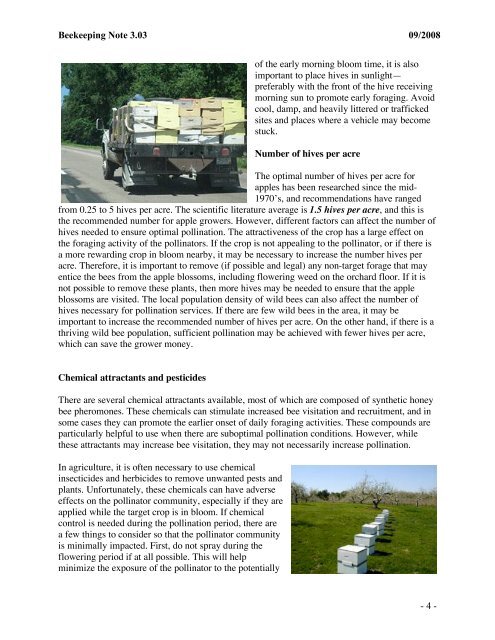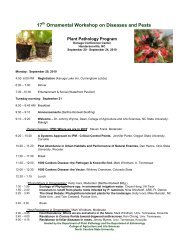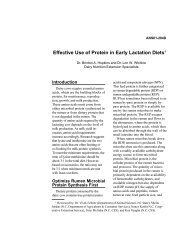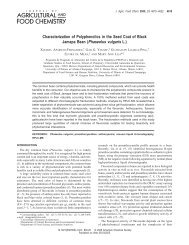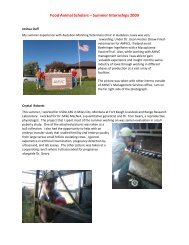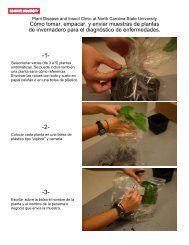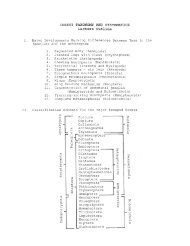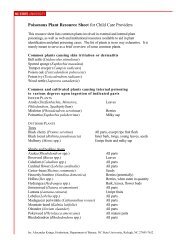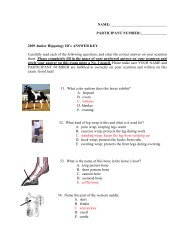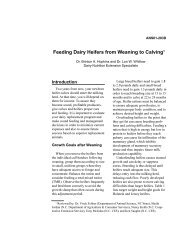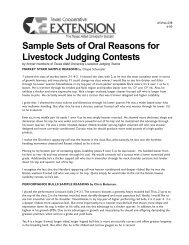the role of honey bees in apple pollination - North Carolina State ...
the role of honey bees in apple pollination - North Carolina State ...
the role of honey bees in apple pollination - North Carolina State ...
Create successful ePaper yourself
Turn your PDF publications into a flip-book with our unique Google optimized e-Paper software.
Beekeep<strong>in</strong>g Note 3.03 09/2008<br />
<strong>of</strong> <strong>the</strong> early morn<strong>in</strong>g bloom time, it is also<br />
important to place hives <strong>in</strong> sunlight—<br />
preferably with <strong>the</strong> front <strong>of</strong> <strong>the</strong> hive receiv<strong>in</strong>g<br />
morn<strong>in</strong>g sun to promote early forag<strong>in</strong>g. Avoid<br />
cool, damp, and heavily littered or trafficked<br />
sites and places where a vehicle may become<br />
stuck.<br />
Number <strong>of</strong> hives per acre<br />
The optimal number <strong>of</strong> hives per acre for<br />
<strong>apple</strong>s has been researched s<strong>in</strong>ce <strong>the</strong> mid-<br />
1970’s, and recommendations have ranged<br />
from 0.25 to 5 hives per acre. The scientific literature average is 1.5 hives per acre, and this is<br />
<strong>the</strong> recommended number for <strong>apple</strong> growers. However, different factors can affect <strong>the</strong> number <strong>of</strong><br />
hives needed to ensure optimal poll<strong>in</strong>ation. The attractiveness <strong>of</strong> <strong>the</strong> crop has a large effect on<br />
<strong>the</strong> forag<strong>in</strong>g activity <strong>of</strong> <strong>the</strong> poll<strong>in</strong>ators. If <strong>the</strong> crop is not appeal<strong>in</strong>g to <strong>the</strong> poll<strong>in</strong>ator, or if <strong>the</strong>re is<br />
a more reward<strong>in</strong>g crop <strong>in</strong> bloom nearby, it may be necessary to <strong>in</strong>crease <strong>the</strong> number hives per<br />
acre. Therefore, it is important to remove (if possible and legal) any non-target forage that may<br />
entice <strong>the</strong> <strong>bees</strong> from <strong>the</strong> <strong>apple</strong> blossoms, <strong>in</strong>clud<strong>in</strong>g flower<strong>in</strong>g weed on <strong>the</strong> orchard floor. If it is<br />
not possible to remove <strong>the</strong>se plants, <strong>the</strong>n more hives may be needed to ensure that <strong>the</strong> <strong>apple</strong><br />
blossoms are visited. The local population density <strong>of</strong> wild <strong>bees</strong> can also affect <strong>the</strong> number <strong>of</strong><br />
hives necessary for poll<strong>in</strong>ation services. If <strong>the</strong>re are few wild <strong>bees</strong> <strong>in</strong> <strong>the</strong> area, it may be<br />
important to <strong>in</strong>crease <strong>the</strong> recommended number <strong>of</strong> hives per acre. On <strong>the</strong> o<strong>the</strong>r hand, if <strong>the</strong>re is a<br />
thriv<strong>in</strong>g wild bee population, sufficient poll<strong>in</strong>ation may be achieved with fewer hives per acre,<br />
which can save <strong>the</strong> grower money.<br />
Chemical attractants and pesticides<br />
There are several chemical attractants available, most <strong>of</strong> which are composed <strong>of</strong> syn<strong>the</strong>tic <strong>honey</strong><br />
bee pheromones. These chemicals can stimulate <strong>in</strong>creased bee visitation and recruitment, and <strong>in</strong><br />
some cases <strong>the</strong>y can promote <strong>the</strong> earlier onset <strong>of</strong> daily forag<strong>in</strong>g activities. These compounds are<br />
particularly helpful to use when <strong>the</strong>re are suboptimal poll<strong>in</strong>ation conditions. However, while<br />
<strong>the</strong>se attractants may <strong>in</strong>crease bee visitation, <strong>the</strong>y may not necessarily <strong>in</strong>crease poll<strong>in</strong>ation.<br />
In agriculture, it is <strong>of</strong>ten necessary to use chemical<br />
<strong>in</strong>secticides and herbicides to remove unwanted pests and<br />
plants. Unfortunately, <strong>the</strong>se chemicals can have adverse<br />
effects on <strong>the</strong> poll<strong>in</strong>ator community, especially if <strong>the</strong>y are<br />
applied while <strong>the</strong> target crop is <strong>in</strong> bloom. If chemical<br />
control is needed dur<strong>in</strong>g <strong>the</strong> poll<strong>in</strong>ation period, <strong>the</strong>re are<br />
a few th<strong>in</strong>gs to consider so that <strong>the</strong> poll<strong>in</strong>ator community<br />
is m<strong>in</strong>imally impacted. First, do not spray dur<strong>in</strong>g <strong>the</strong><br />
flower<strong>in</strong>g period if at all possible. This will help<br />
m<strong>in</strong>imize <strong>the</strong> exposure <strong>of</strong> <strong>the</strong> poll<strong>in</strong>ator to <strong>the</strong> potentially<br />
- 4 -


